A Retrospective Assessment of Türkiye’s Recent Energy Policy in Terms of Energy Security and Climate Change Mitigation
Abstract
1. Introduction
2. Materials and Methods
2.1. Methodology
2.2. Data and Forecast
3. Scenario Results and Discussion
3.1. Business-As-Usual (BAU)
3.2. 60 TWh Domestic Coal-Based Generation
3.3. Full Domestic Coal (FullDC)
3.4. 45 GW Installed Wind Capacity (45GWWind)
3.5. Maxiumum Solar Power (MaxSP)
4. Conclusions
Supplementary Materials
Author Contributions
Funding
Data Availability Statement
Conflicts of Interest
Nomenclature
| Abbreviation | Explanation |
| BAU | Business-As-Usual |
| CTP | Coal-fired Thermal Power |
| GDP | Gross Domestic Product |
| GHG | Greenhouse Gas |
| GTP | Gas-fired Thermal Power |
| IEA | International Energy Agency |
| IPCC | Intergovernmental Panel for Climate Change |
| MENR | Ministry of Energy and Natural Resources |
| mtoe | Million Tons Oil Equivalent |
| NDC | Nationally Determined Contribution |
| OECD | Organization for Economic Cooperation and Development |
| PE | Panel Equation |
| SP | Solar Power |
| TEİAŞ | Turkish Electricity Transmission Corporation |
| TUIK | Turkish Statistics Institution |
| TWh | Terawatt Hours |
| WDI | World Development Indicators Database |
| WP | Wind Power |
References
- Dewdney, J.C.; Yapp, M.E. Turkey. Encyclopædia Britannica. 2020. Available online: https://www.britannica.com/place/Turkey (accessed on 10 March 2020).
- The World Bank Group. The World Bank in Türkiye. 2024. Available online: https://www.worldbank.org/en/country/turkey/overview (accessed on 28 November 2024).
- Çimen, S. “Enerji Güvenliği: Dünya ve Türkiye” Paneli. In Dünya’da ve Türkiye’de Enerji Sektörü; Dündar, D., İşeri, M., Pamir, N., Eds.; TC İstanbul Kültür Üniversitesi: İstanbul, Turkey, 2010; pp. 21–37. [Google Scholar]
- Özalp, M. Küresel Ölçekte Türkiye’nin Enerji Arz ve Talep Güvenliği. J. Turk. Stud. 2019, 14, 537–552. [Google Scholar] [CrossRef]
- Toprak, N.G. Turkey’s Energy Security Policy within the Framework of Development Plans. EnergyTR 2024, 1, 73–92. [Google Scholar]
- Yilmaz, A.O.; Uslu, T. The role of coal in energy production-Consumption and sustainable development of Turkey. Energy Policy 2007, 35, 1117–1128. [Google Scholar] [CrossRef]
- ETKB. Elektrik Enerjisi Piyasası ve Arz Güvenliği Strateji Belgesi; Ministry of Energy and Natural Resources: Ankara, Turkey, 2009. [Google Scholar]
- ETKB. Enerji ve Tabii Kaynaklar Bakanlığı 2015–2019 Stratejik Planı; ETKB: Ankara, Turkey, 2017. [Google Scholar]
- Soylu, O.B.; Turel, M.; Balsalobre-Lorente, D.; Radulescu, M. Evaluating the impacts of renewable energy action plans: A synthetic control approach to the Turkish case. Heliyon 2024, 10, e25902. [Google Scholar] [CrossRef] [PubMed]
- Bruckner, T.; Bashmakov, I.A.; Mulugetta, Y.; Chum, H.; de la Vega Navarro, A.; Edmonds, J.; Faaij, A.; Fungtammasan, B.; Garg, A.; Hertwich, E.; et al. Energy systems. In Climate Change 2014: Mitigation of Climate Change Contribution of Working Group III to the Fifth Assessment Report of the Intergovernmental Panel on Climate Change; Edenhofer, O., Pichs-Madruga, R., Sokona, Y., Farahani, E., Kadner, S., Seyboth, K., Eds.; Cambridge University Press: Cambridge, UK; New York, NY, USA, 2014; pp. 511–597. [Google Scholar]
- Bridges, A.; Felder, F.A.; McKelvey, K.; Niyogi, I. Uncertainty in energy planning: Estimating the health impacts of air pollution from fossil fuel electricity generation. Energy Res. Soc. Sci. 2015, 6, 74–77. [Google Scholar] [CrossRef]
- Zhu, J.; Cheung, K. Summary of environment impact of renewable energy resources. Adv. Mater. Res. 2013, 616–618, 1133–1136. [Google Scholar] [CrossRef]
- Oluwatoyin, K.; Oluwasegun, A.; Alabi, A. Power Generation and Its Impacts on the Environment. J. Sci. Res. Rep. 2015, 7, 551–566. [Google Scholar] [CrossRef] [PubMed]
- Zhao, S.; Suo, X.; Ma, Y.; Dong, L. Multi-Point Layout Planning Method for Multi-Energy Power System Based on Complex Adaptive System Theory. CSEE J. Power Energy Syst. 2024, 10, 2138–2146. Available online: https://ieeexplore.ieee.org/stamp/stamp.jsp?tp=&arnumber=9606942 (accessed on 2 February 2025).
- Gkalonaki, S.; Karatzas, K. Assessing the environmental impacts of renewable energy sources with emphasis on wind energy. In IOP Conference Series: Earth and Environmental Science, Proceedings of the 3rd International Conference on Environmental Design (ICED2022), Athens, Greece, 22–23 October; IOP Publishing Ltd.: Bristol, UK, 2022. [Google Scholar]
- Cansın, Y. Enerji Güvenliğinin Değerlendirilmesine Yönelik Temel Göstergelerin Küresel Eğilimler İle Ulusal Tehdit Algılamaları Ekseninde Analizi. Master’s Thesis, İstanbul Teknik Üniversitesi, İstanbul, Turkey, 2007. [Google Scholar]
- Kardaşlar, S. Türkiye’nin Enerji Güvenliğinde Yenilenebilir Kaynakların Rolü. Master’s Thesis, Harp Akademileri Stratejik Araştırmalar Enstitüsü, Ankara, Turkey, 2016. [Google Scholar]
- Dursun, S. Enerji Bağımlılığı: Türkiye ve İsveç Karşılaştırması. Master’s Thesis, Ege Üniversitesi, İzmir, Turkey, 2019. [Google Scholar]
- Kocaslan, G. International energy security indicators and Turkey’s energy security risk score. Int. J. Energy Econ. Policy 2014, 4, 735–743. [Google Scholar]
- Peker, H.S. Türkiye’nin Enerji Arz Güvenliği ve Ölçülmesi: Türkiye’nin Enerji Arz Güvenliği Endeksine Yönelik Bir Uygulama. Master’s Thesis, Selçuk Üniversitesi, Selçuk, Turkey, 2014. [Google Scholar]
- Öznazik, H.A. Türkiye’de Enerji Arz Güvenliği: Uygulanan Politikalar ve Etkileri. Master’s Thesis, Gazi Üniversitesi, Ankara, Turkey, 2019. [Google Scholar]
- Erdal, L. Enerji Arz Güvenliğini Etkileyen Faktörler Ve Yenilenebilir Enerji Kaynakları Alternatifi. Ph.D. Thesis, Adnan Menderes Üniversitesi, Adnan, Turkey, 2011. [Google Scholar]
- Dogan, M. A Public Energy Policy Proposal for Turkey in the Light of Econometric Findings. Kırklareli Üniversitesi Sos. Bilim. Mesl. Yüksekokulu Derg. 2023, 4, 1–23. [Google Scholar] [CrossRef]
- Erdal, L. Determinants of Energy Supply Security: An Econometric Analysis for Turkey. Ege Akad. Bakis (Ege Acad. Rev.) 2015, 15, 153–164. [Google Scholar] [CrossRef]
- Avar, A. Türkiye’nin Enerji Arz Güvenliğinin Ekonometrik Analizi. Master’s Thesis, Akdeniz Üniversitesi, Antalya, Turkey, 2018. [Google Scholar]
- Çoruh, B. Enerji Arz Güvenliği Kapsamında Türkiye’nin Enerji Politikaları. Master’s Thesis, Kahramanmaraş Sütçü İmam Üniversitesi, Onikişubat, Turkey, 2019. [Google Scholar]
- Arı, İ. Investigating the CO2 Emission of Turkish Electricity Sector and Its Mitigation Potential. Master’s Thesis, Middle East Technical University, Ankara, Turkey, 2010. [Google Scholar]
- Arı, İ.; Köksal, M.A. Carbon dioxide emission from the Turkish electricity sector and its mitigation options. Energy Policy 2011, 39, 6120–6135. [Google Scholar] [CrossRef]
- Boran, F.E.; Dizdar, E.; Toktas, I.; Boran, K.; Eldem, C. A Multidimensional Analysis of Electricity Generation Options with Different Scenarios in Turkey. Energy Sources Part B Econ. Plan. Policy 2013, 8, 44–55. [Google Scholar] [CrossRef]
- Atılgan, B.; Azapagic, A. Life cycle environmental impacts of electricity from fossil fuels in Turkey. J. Clean. Prod. 2015, 106, 555–564. [Google Scholar] [CrossRef]
- Özcan, M. Estimation of Turkey’s GHG emissions from electricity generation by fuel types. Renew. Sustain. Energy Rev. 2016, 53, 832–840. [Google Scholar] [CrossRef]
- Dulkadiroğlu, H. Türkiye’de Elektrik Üretiminin Sera Gazı Emisyonları Açısından İncelenmesi. Ömer Halisdemir Üniversitesi Mühendislik Bilim. Derg. 2018, 7, 67–74. [Google Scholar]
- Aydın, L. Effects of increasing indigenous coal share in Turkey’s electricity generation mix on key economic and environmental indicators: An extended input–output analysis. Energy Explor. Exploit. 2018, 36, 230–245. [Google Scholar] [CrossRef]
- Dikmen, A.Ç. Türkiye’de Güneş ve Rüzgar Enerjisinden Elektrik Üretiminin Sera Gazı Emisyonları ve Çevre Maliyetinin Azaltılmasına Katkıları. Turk. Stud. 2019, 14, 275–293. [Google Scholar] [CrossRef]
- Önenli, Ö. Emission Reductions and Future of Energy Policies in Turkey. Are Renewables an Alternative? Ph.D. Thesis, Middle East Technical University, Ankara, Turkey, 2019. [Google Scholar]
- Arı, İ.; Yıkmaz, R.F. The role of renewable energy in achieving Turkey’s INDC. Renew. Sustain. Energy Rev. 2019, 105, 244–251. [Google Scholar] [CrossRef]
- Saint Akadiri, S.; Adewale Alola, A.; Olasehinde-Williams, G.; Udom Etokakpan, M. The role of electricity consumption, globalization and economic growth in carbon dioxide emissions and its implications for environmental sustainability targets. Sci. Total Environ. 2020, 708, 134653–134662. [Google Scholar] [CrossRef]
- Onenli, O.; Ercan, H.; Acikgoz, S.; Kat, B. Emission reduction pathways for satisfying Türkiye’s future electricity demand: A cross-country dynamic panel analysis with linear programming scenarios. Clean. Energy Syst. 2023, 6, 100085. [Google Scholar] [CrossRef]
- Gungor, G.; Sari, R. Meta-analysis of the Turkish energy and climate pathways to achieve the net-zero emission target. Energy 2024, 305, 132337. [Google Scholar] [CrossRef]
- Gül, H.H.M.; Açıkgöz, Ş.; Ercan, H.; Akınoğlu, B. Securing energy while mitigating climate change. Energy Clim. Chang. 2022, 3, 100085. [Google Scholar] [CrossRef]
- Hill, R.C.; Griffiths, W.E.; Lim, G.C. Principles of Econometrics International Student Version, 4th ed.; John Wiley & Sons, Inc.: Singapore, 2012; 758p. [Google Scholar]
- Baltagi, B.H. Econometrics, 5th ed.; Springer: Berlin/Heidelberg, Germany, 2011; 410p. [Google Scholar]
- Lu, Y.; Yi, F.; Yu, S.; Feng, Y.; Wang, Y. Pathways to Sustainable Deployment of Solar Photovoltaic Policies in 20 Leading Countries Using a Qualitative Comparative Analysis. Sustainability 2022, 14, 5858. [Google Scholar] [CrossRef]
- Balat, M. Security of energy supply in Turkey: Challenges and solutions. Energy Convers. Manag. 2010, 51, 1998–2011. [Google Scholar] [CrossRef]
- Deese, D.A. Energy: Economics, Politics, and Security. Int. Secur. 1979, 4, 140–153. [Google Scholar] [CrossRef]
- The World Bank Group. Energy Security Issues; The World Bank Group: Moscow, Russia; Washington, DC, USA, 2005. [Google Scholar]

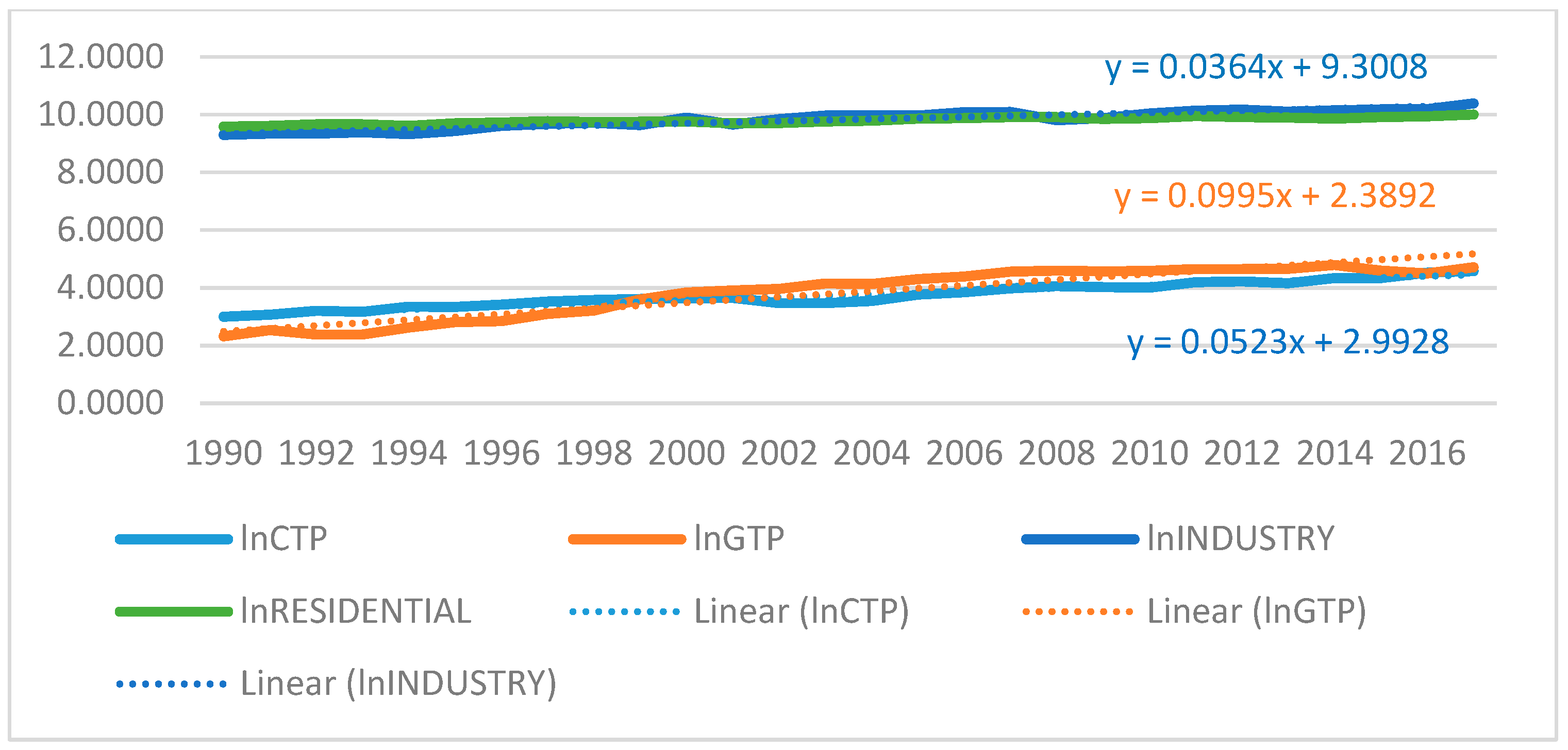

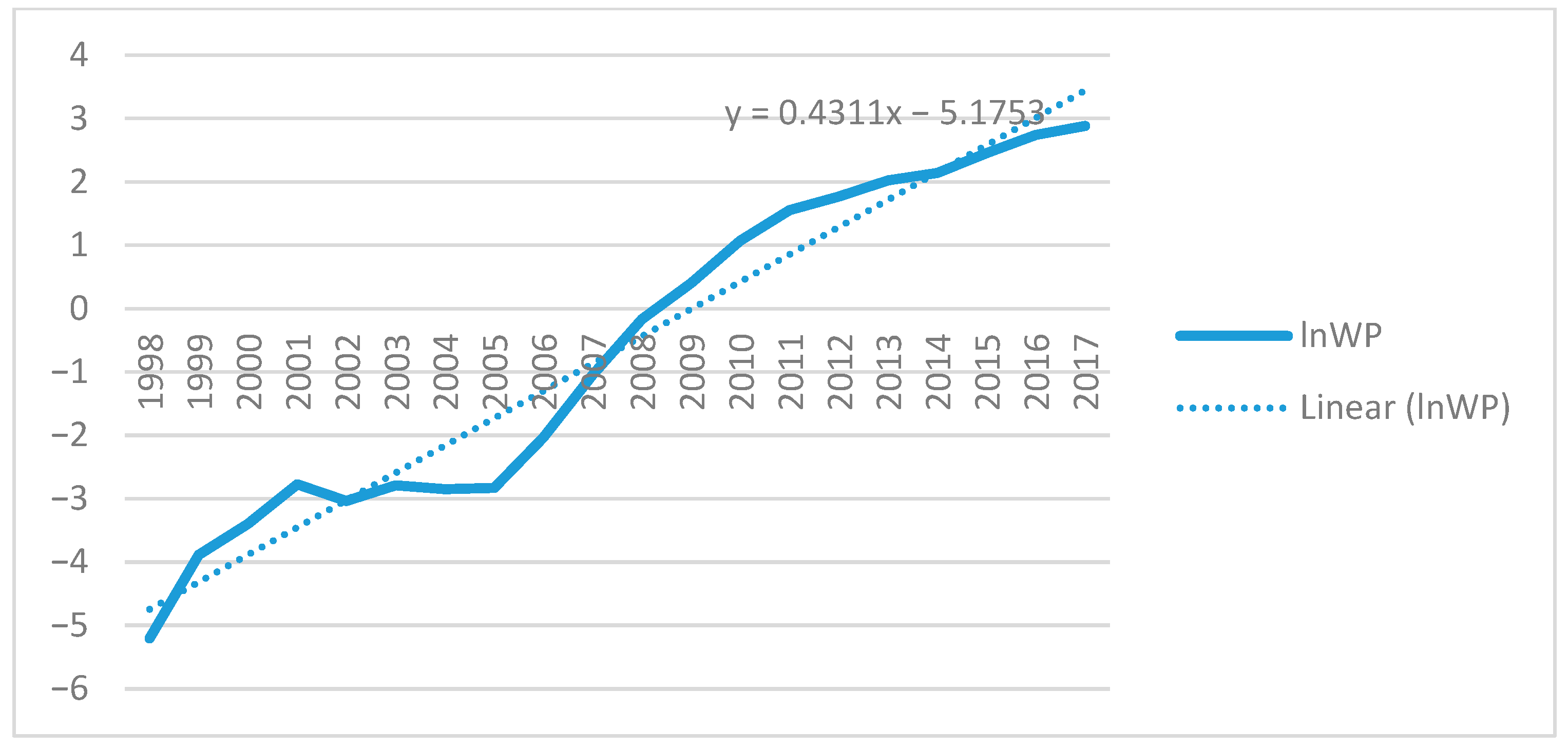
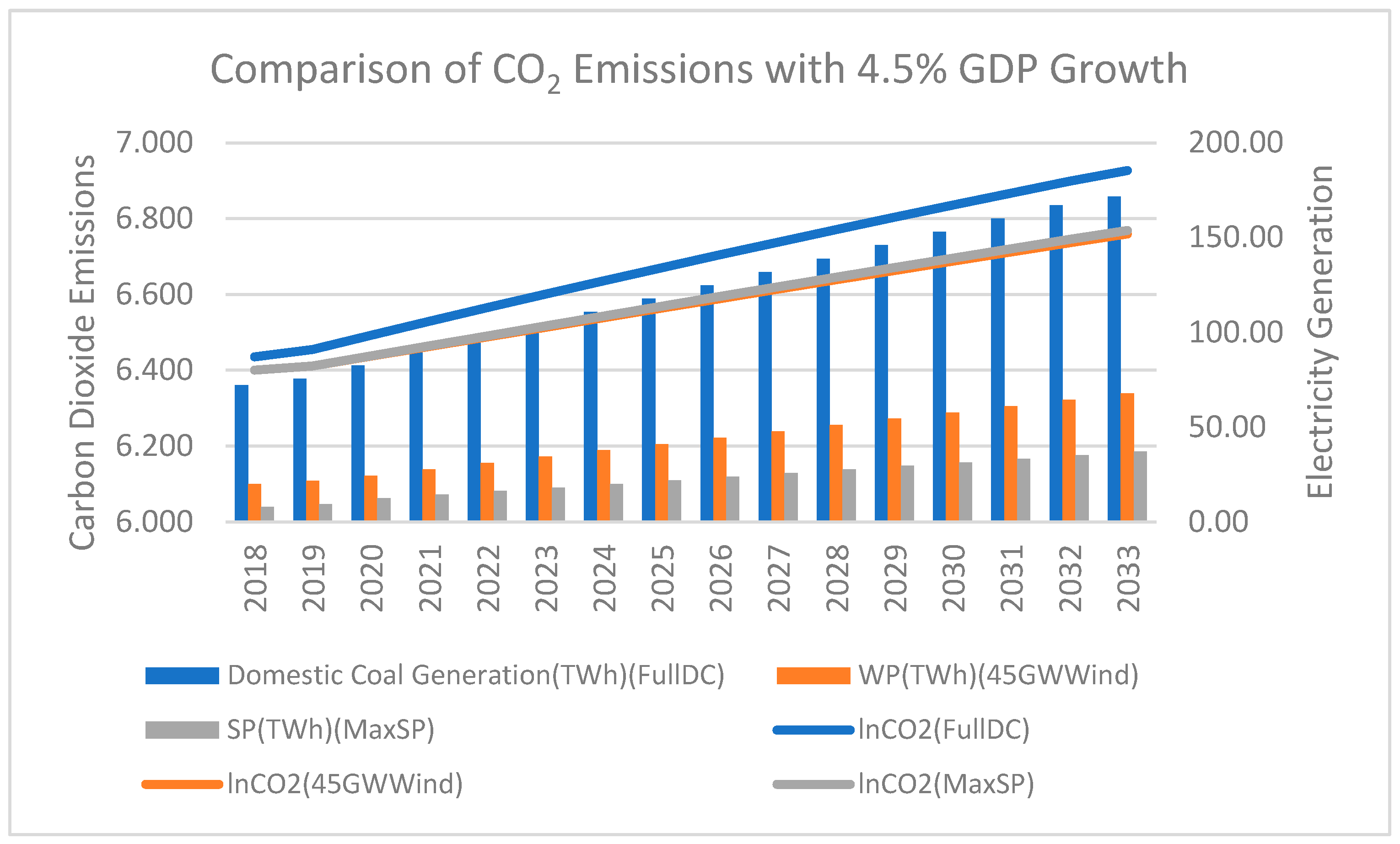


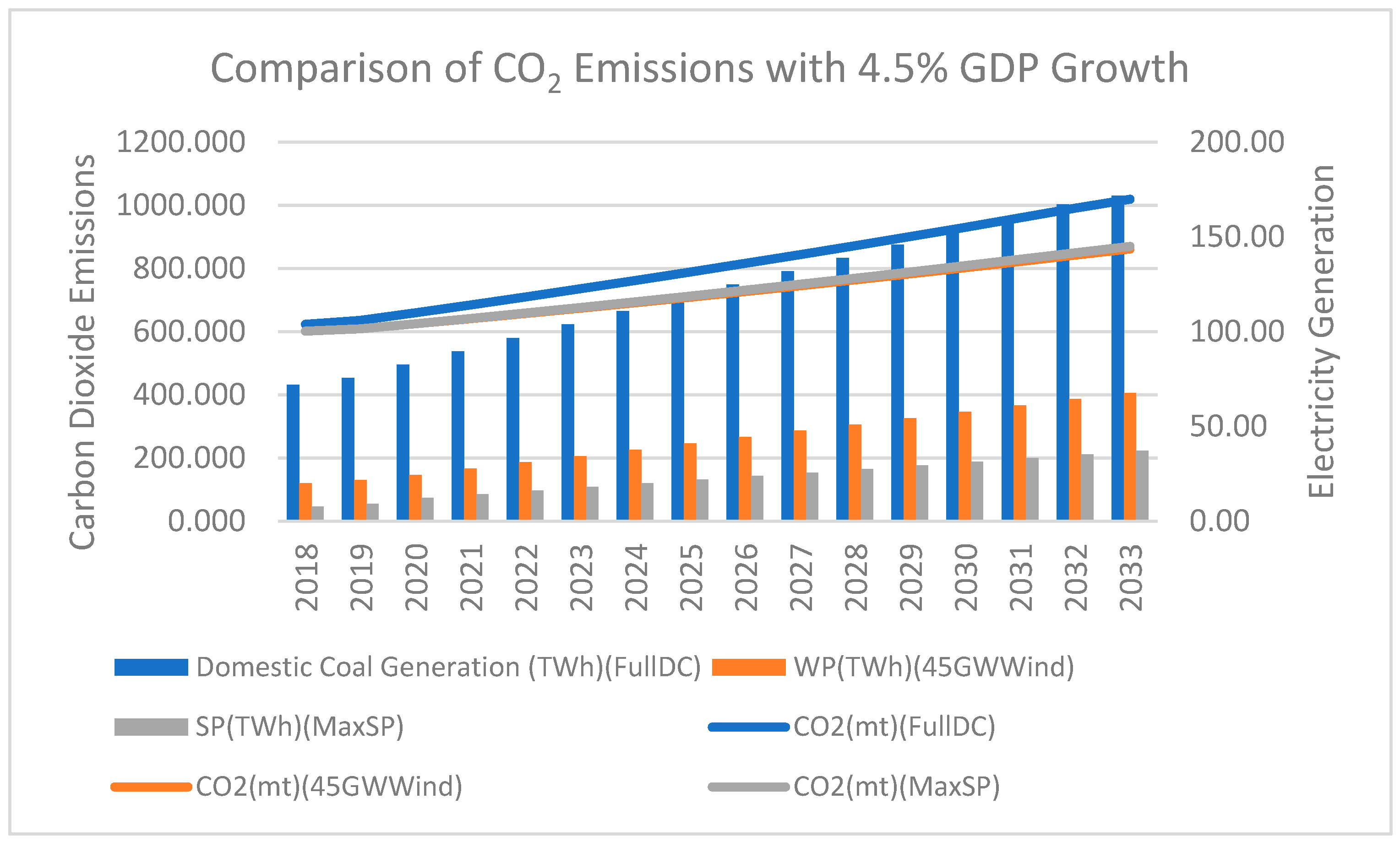
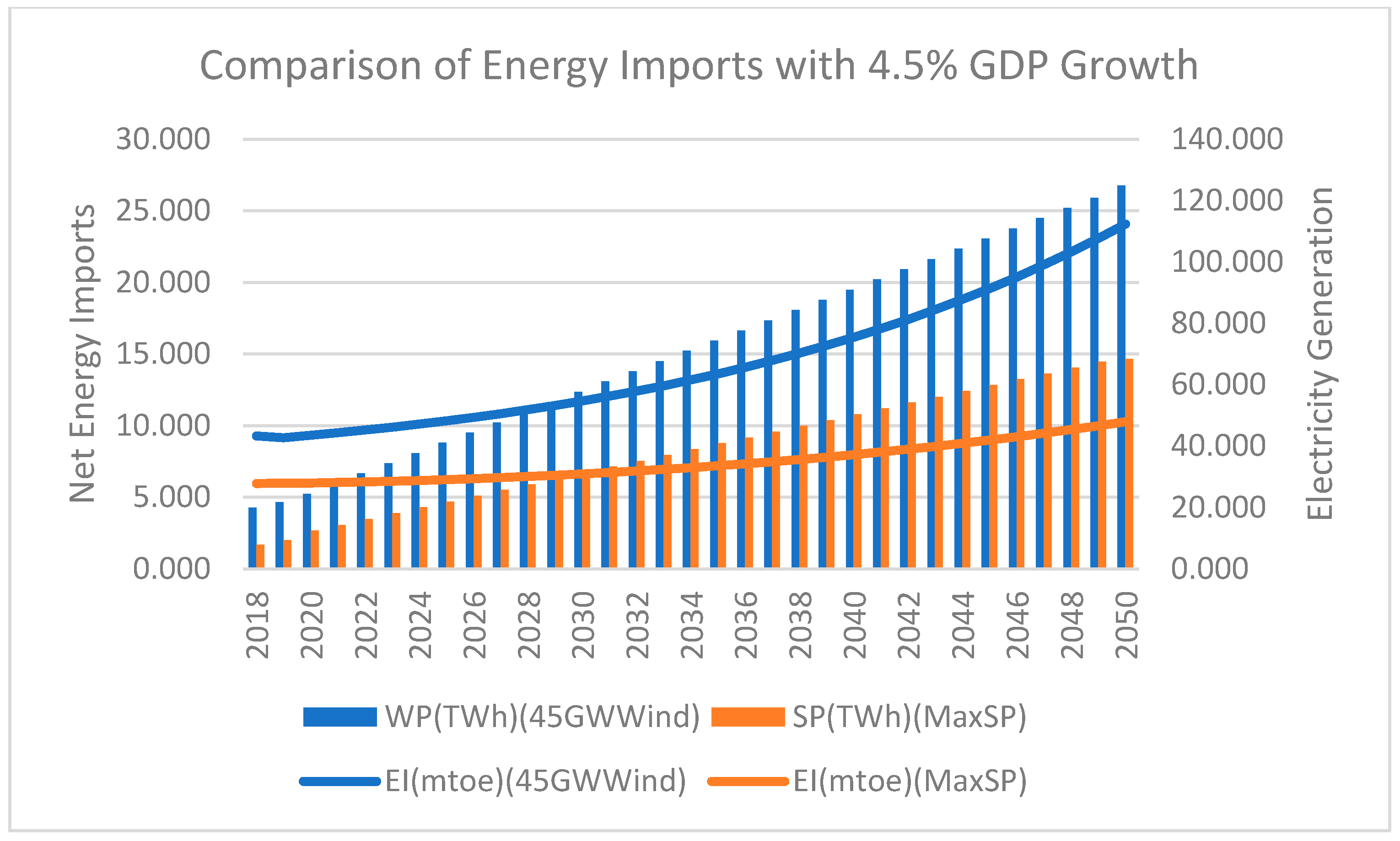
| Variable | Label |
|---|---|
| CO2 | Carbon dioxide emissions, millions of tonnes |
| EI | Net energy imports, million tonnes of oil equivalent |
| CTP | Electricity generation by coal, TWh |
| GTP | Electricity generation from natural gas sources, TWh |
| SP | Electricity generation by solar pv, gross output, TWh |
| WP | Electricity generation from wind power, gross output, TWh |
| NP | Electricity generation from nuclear power, TWh |
| INDUSTRY | Total final energy consumption by industry sector, ktoe |
| RESIDENTIAL | Total final energy consumption by residential sector, ktoe |
| ENERGYINTENSITY | Total primary energy supply by GDP, tonne per 2010 constant USD |
| GDP | Current billion USD |
| POP | Total population, million |
| Variable | Obs | Mean | Std.Dev. | Min | Max |
|---|---|---|---|---|---|
| lnCO2 | 1292 | 4.81 | 1.618 | 0.693 | 9.133 |
| lnEI | 989 | 3.2 | 1.522 | 0 | 6.601 |
| lnCTP | 1188 | 3.117 | 2.242 | −6.908 | 8.409 |
| lnGTP | 1232 | 2.248 | 2.33 | −6.804 | 7.257 |
| lnSP | 785 | −3.213 | 3.121 | −11.513 | 4.769 |
| lnWP | 959 | −1.226 | 3.108 | −11.744 | 5.687 |
| lnINDUSTRY | 1292 | 9.316 | 1.568 | 5.864 | 13.837 |
| lnRESIDENTIAL | 1292 | 9.079 | 1.558 | 5.609 | 12.718 |
| lnCARBONINTENSITY | 1292 | −1.12 | 0.695 | −2.813 | 0.924 |
| lnGDP | 1292 | 5.631 | 1.587 | 1.388 | 9.877 |
| lnPOP | 1292 | 3.054 | 1.763 | −1.367 | 7.234 |
| Scenario | Assumptions | Determinant Variable |
|---|---|---|
| Business-as-Usual1 (BAU1) | All variables except GDP and POP increase according to historical trends. | GDP |
| Business-as-Usual2 (BAU2) | All variables except GDP and POP increase according to historical trends. | GDP |
| Business-as-Usual3 (BAU3) | All variables except GDP and POP increase according to historical trends. | GDP |
| 60 TWh Domestic Coal (60TWhDC) | Electricity generation and GDP variables are real values. Domestic coal-based generation is 60 TWh by the end of 2019. | CTP |
| Full Domestic Coal (FullDC) | All domestic coal potential is used until 2033. The additional capacity is 13,670 MW. The annual increase in installed domestic coal capacity is 1000 MW. CF is taken as constant at the 2019 value for all years. WP, SP, GTP, and imported coal are kept constant at 2019 values. | CTP |
| 45 GW Installed Wind (45GWWind) | All wind potential is used until 2050. The annual increase in installed wind capacity is 1200 MW. CF is taken as constant at the 2019 TEİAŞ value for all years, 38%. The average daily generation is 20 h. CTP, GTP, and SP are kept constant at their 2019 values. | WP |
| Maximum Solar Power (MaxSP) | Total solar potential is 46.8 GW, utilized until 2050. The annual increase in installed solar capacity is 1300 MW. The average net daily solar generation is 4 h. CTP, GTP, and WP are kept at their 2019 values. | SP |
| Year | MENA Domestic Coal Generation Target (TWh) | TEİAŞ Hard Coal + Imported Coal + Asphaltite (TWh) | TEİAŞ Lignite (TWh) | Hours/Day Lignite Used for Electricity Generation | Hard Coal + Asphaltite (TWh) | Total Domestic Coal (TWh) | CF by TEİAŞ for Fossil Fuel |
|---|---|---|---|---|---|---|---|
| 2013 | 32.9 | ||||||
| 2015 | 40 | 44.83 | 31.34 | 15.93 | 4.39 | 35.73 | 0.622 |
| 2016 | 53.70 | 38.57 | 18.41 | 5.07 | 43.64 | 0.629 | |
| 2017 | 50 | 56.78 | 40.69 | 19.02 | 5.43 | 46.13 | 0.642 |
| 2018 | 68.16 | 45.09 | 19.94 | 5.70 | 50.78 | 0.655 | |
| 2019 | 60 | 66.02 | 46.87 | 19.26 | 5.50 | 52.37 | 0.669 |
 realized;
realized;  estimate.
estimate.Disclaimer/Publisher’s Note: The statements, opinions and data contained in all publications are solely those of the individual author(s) and contributor(s) and not of MDPI and/or the editor(s). MDPI and/or the editor(s) disclaim responsibility for any injury to people or property resulting from any ideas, methods, instructions or products referred to in the content. |
© 2025 by the authors. Licensee MDPI, Basel, Switzerland. This article is an open access article distributed under the terms and conditions of the Creative Commons Attribution (CC BY) license (https://creativecommons.org/licenses/by/4.0/).
Share and Cite
Gül, H.H.M.; Ercan, H.; Akınoğlu, B.; Açıkgöz, Ş. A Retrospective Assessment of Türkiye’s Recent Energy Policy in Terms of Energy Security and Climate Change Mitigation. Energies 2025, 18, 951. https://doi.org/10.3390/en18040951
Gül HHM, Ercan H, Akınoğlu B, Açıkgöz Ş. A Retrospective Assessment of Türkiye’s Recent Energy Policy in Terms of Energy Security and Climate Change Mitigation. Energies. 2025; 18(4):951. https://doi.org/10.3390/en18040951
Chicago/Turabian StyleGül, Hasan Hüseyin Miraç, Hakan Ercan, Bülent Akınoğlu, and Şenay Açıkgöz. 2025. "A Retrospective Assessment of Türkiye’s Recent Energy Policy in Terms of Energy Security and Climate Change Mitigation" Energies 18, no. 4: 951. https://doi.org/10.3390/en18040951
APA StyleGül, H. H. M., Ercan, H., Akınoğlu, B., & Açıkgöz, Ş. (2025). A Retrospective Assessment of Türkiye’s Recent Energy Policy in Terms of Energy Security and Climate Change Mitigation. Energies, 18(4), 951. https://doi.org/10.3390/en18040951






